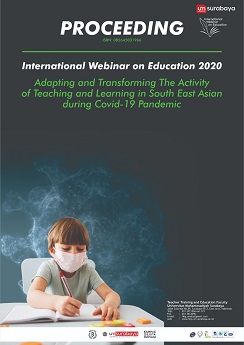Explorative study on the application of learning model in virtual classroom during Covid-19 pandemic at the school of Yogyakarta Province
Abstrak
Abstract.
Since Covid-19 was established as a global pandemic and by National Disaster
Management Authority established the status of a national emergency, the government enact work from home since last March. This makes the learning process changed from classical learning to be non-classical or distance learning. This could be said to be minimal preparation because distance learning decisions are taken suddenly as non-classical learning solutions following work from home and study from home decisions. This study aimed to determine the implementation of online learning activities during the Covid-19 pandemic in Yogyakarta. The technique samples were taken randomly covering 4 districts and 1 municipality in Yogyakarta. These conditions force all parties to try to maximize the learning process with due regard to all aspects of support. The results showed that sequentially the most widely used applications to assist in distance learning were Google Classroom, What‘s Application, and Zoom Clouds Meeting. The majority of teachers still apply learning model in virtual learning. The 3 popular learning models to be applied are Cooperative, PBL and PjBL. The teacher states that the learning model applied is very helpful for their work to realize a virtual classroom, helping students to better understand the material delivered, because it follows the systematic syntax on the learning model used. The application of learning models in each meeting in virtual classrooms was arranged varied to optimize learning and maximize the saturation experienced by students. In addition, various learning methods are applied to support predetermined learning models.
Referensi
Anonim. (2020, May 30). WHO Coronavirus Disease (COVID-19) Dashboard[Online].Available: https://covid19.who.int/gclid=CjwKCAjwiMj2BRBFEiwAYfTbCod9hYnKI6jtuqIoHEVnStP_VrjFu3NFnfkKJSgh9rZcBuI7mtmfDhoCuYcQAvD_BwE
Slameto. (2020, April 8). 5 Fakta Pendidikan di Tengah Wabah Corona [Online]. Available: https://news.detik.com/kolom/d-4969335/5-fakta pendidikan-di-tengah-wabah-corona]
Centers for Disease Control and Prevention. (2020, March 4). Transmission of Coronavirus Disease 2019 (COVID-19). [Online]. Available: https://www.cdc.gov/coronavirus/2019 ncov/prepare/transmission.html
Centers for Disease Control and Prevention. (2020, March 28). Community NPIs: Everyday Preventative Actions. [Online]. Available:
https://www.cdc.gov/nonpharmaceuticalinterventions/community/index/html
S. W. Utami. ―Penerapanpendidikankaraktermelaluikegiatankedisiplinansiswa,‖ JurnalPendidikan., vol. 04, no. 01, pp.63-66, 2019.
G. F. Prassida and A. Muklason, ―Virtual class
sebagaistrategipembelajaranuntukpeningkatankualitas student-centered learning di perguruantinggi‘, JurnalTeknologi, vol. 1, no. 2, pp. 95-98, 2011.
I. Dwi, et al. The implementation of problem based learning model on teachers and students grade five elementary schools in Surakarta city. International journal of Active Learning, vol. 3, no. 2, pp. 116-123, 2018.
Gunawan, et al., The effect of project based learning with virtual media assistance on student‘s creativity in physics. JurnalCakrawalaPendidikan, vol. 36, no. 2, pp. 167-179, 2017.
C. Bliss, andB. Lawrence, Is the whole greater than the sum of its parts? A comparison of small group and whole class discussion board activity in online courses. Journal of Asynchronous Learning Networks, vol. 1, no. 13. pp. 25-39.2009.
L. Kupezynski, et al. Cooperative learning in distance learning: a mixed methods study. International Journal of Instruction, vol. 5, no. 2, pp.81-90, 2012.
L. J. Molcong, Metodologi Penelitian KualitaTif. Bandung: PT Remaja Rosdakarya, pp. 6, 2008.
Hayati, (2019, May 16). Pengertian Penelitian Eksplorasi, Macam, Ciri, dan Cara Menulisnya [Online]. Available:https://penelitianilmiah.com/penelitianeksplorasi/[Accessed
Sugiono, MetodePenelitianKuantitatifKualitatifdan R&D. Bandung: CV Alfabeta, 2017, pp.128-129.
A. Prastowo,MetodePenelitianKualitatifdalanPerspektifRancanganPenelitian. Yogyakarta:Ar-Ruzz Media,2012, pp. 248.
P. Slatettery,Curriculum Development in the Postmodern Era Second Edition. NewYork: Routledge Taylor and Francis Group, 2006, pp. 180.
R. Andrews, et al, Teaching and Learning Design and Technology. New York: Continuum,2000, pp. 20.
B. Suranto, ―Virtual Classroom: StrategiPembelajaranBerbasis Synchronous E-Learning‖, in
Seminar NasionalAplikasiTeknologiInformasi 2009 (SNATI 2009), pp. 78, June 20 , 2009.Available: http://journal.uii.ac.id/index.php/Snati/article/view/1221/1009
T. Syarifudin, Landasan Pendidikan cetakan I. Jakarta: Dirjen Pendidikan Islam Depag RI,2009, pp. 9, 112.
M. Burns. Distance Education for Teacher Training: Modes, Models, and Methods.Washington: EDC Learning Transform Lives, pp. 10, 289, 2011.
K. Passerini and M.J. Granger, ―A developmental model for distance learning using the Internet‖, Computers & Education Journal. Vol.34. No. 1, pp.1-15, 2000.
F. B. King, et al. (2014, May), Defining Distance Learning and Distance Education[Online]. Avaialable: https://www.researchgate.net/publication/228716418
Anonim, (2020, March),Cooperative Learning [Online].
Available:https://www.k12academics.com/education-reform/cooperative-learning/types
S. Wurdinger and J. Rudolph, ―Teaching practices that improve student learning: Five experiential approaches,‖ Journal of Teaching and Learning, vol. 6, no. 1, 2009.
D. Tillman, ―Implications of problem-based learning (PBL) in elementary schools upon the K-12 engineeringeducation Pipeline‖ in Conference & Exposition The University of Texas at El Paso (UTEp), 2013.
B. J. Roopashree, ―PBL: Future challenges for educational practice and research,‖Journal on School Educational Technology, vol. 10, no. 2, pp. 9-16, 2011.
George Lucas Educational Foundation. (2005). Instructional Module Project Based Learning. Retrieved [Online]. Available: http://www.edutopia.org/modules/.
Capraro, et al. STEM Project-Based Learning: An Integrated Science, Technology, Engineering, And Mathematics (STEM) Approach (second ed.). Rotterdam: Sense Publishers, 2013.
A.K. Sembiring, Hasruddin, & F. Harahap,―The effectiveness of mind map-based projectbased learning and concept map based-projectbased learning in an environmental science course in Universitas Lancang Kuning Pekanbaru,‖.Proceedings of Seminar Nasional XII PendidikanBiologi FKIP UNS, pp. 585-590, 2015.






